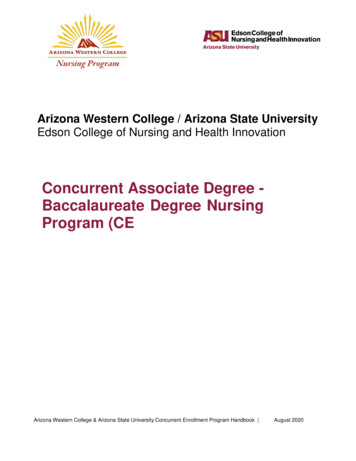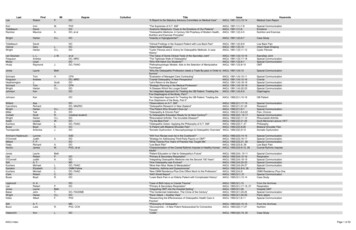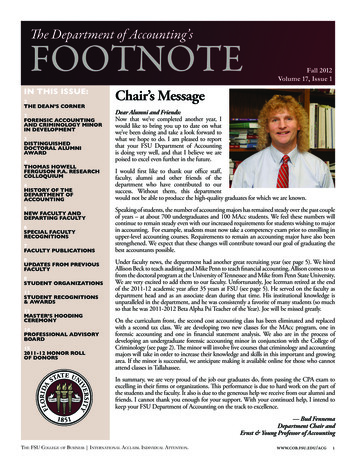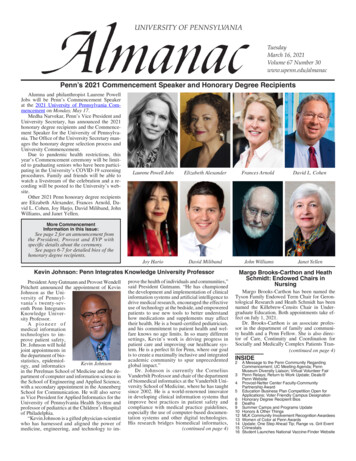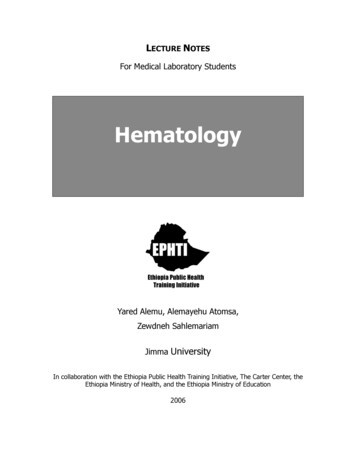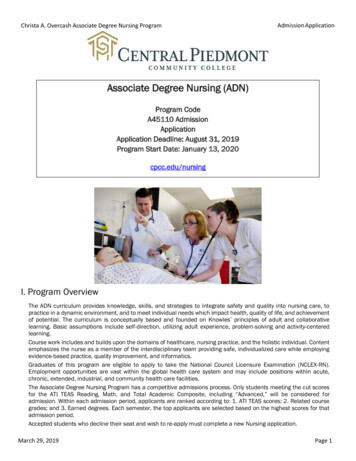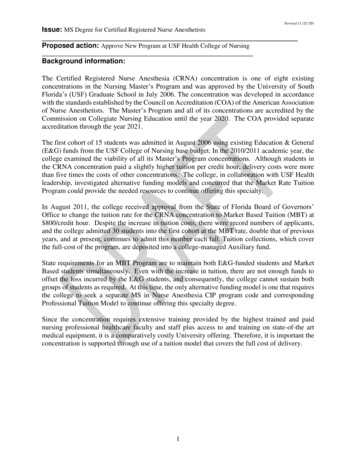
Transcription
Revised 11/23/201Issue: MS Degree for Certified Registered Nurse AnesthetistsProposed action: Approve New Program at USF Health College of NursingBackground information:The Certified Registered Nurse Anesthesia (CRNA) concentration is one of eight existingconcentrations in the Nursing Master’s Program and was approved by the University of SouthFlorida’s (USF) Graduate School in July 2006. The concentration was developed in accordancewith the standards established by the Council on Accreditation (COA) of the American Associationof Nurse Anesthetists. The Master’s Program and all of its concentrations are accredited by theCommission on Collegiate Nursing Education until the year 2020. The COA provided separateaccreditation through the year 2021.The first cohort of 15 students was admitted in August 2006 using existing Education & General(E&G) funds from the USF College of Nursing base budget. In the 2010/2011 academic year, thecollege examined the viability of all its Master’s Program concentrations. Although students inthe CRNA concentration paid a slightly higher tuition per credit hour, delivery costs were morethan five times the costs of other concentrations. The college, in collaboration with USF Healthleadership, investigated alternative funding models and concurred that the Market Rate TuitionProgram could provide the needed resources to continue offering this specialty.In August 2011, the college received approval from the State of Florida Board of Governors’Office to change the tuition rate for the CRNA concentration to Market Based Tuition (MBT) at 800/credit hour. Despite the increase in tuition costs, there were record numbers of applicants,and the college admitted 30 students into the first cohort at the MBT rate, double that of previousyears, and at present, continues to admit this number each fall. Tuition collections, which coverthe full-cost of the program, are deposited into a college-managed Auxiliary fund.State requirements for an MBT Program are to maintain both E&G-funded students and MarketBased students simultaneously. Even with the increase in tuition, there are not enough funds tooffset the loss incurred by the E&G students, and consequently, the college cannot sustain bothgroups of students as required. At this time, the only alternative funding model is one that requiresthe college to seek a separate MS in Nurse Anesthesia CIP program code and correspondingProfessional Tuition Model to continue offering this specialty degree.Since the concentration requires extensive training provided by the highest trained and paidnursing professional healthcare faculty and staff plus access to and training on state-of-the artmedical equipment, it is a comparatively costly University offering. Therefore, it is important theconcentration is supported through use of a tuition model that covers the full cost of delivery.1
Revised 11/23/201Board of Governors, State University System of FloridaRequest to Offer a New Degree ProgramUniversity of South FloridaFall 2015University Submitting ProposalProposed Implementation TermCollege of NursingGraduate ProgramsName of College(s) or School(s)Name of Department(s)/ Division(s)Nurse AnesthesiaMS in Nurse AnesthesiaAcademic Specialty or FieldComplete Name of Degree51.3804Proposed CIP CodeThe submission of this proposal constitutes a commitment by the university that, if theproposal is approved, the necessary financial resources and the criteria for establishingnew programs have been met prior to the initiation of the program.Date Approved by the University Board ofTrusteesPresidentDateSignature of Chair, Board ofTrusteesVice President for AcademicAffairsDateDateProvide headcount (HC) and full-time equivalent (FTE) student estimates of majors forYears 1 through 5. HC and FTE estimates should be identical to those in Table 1 inAppendix A. Indicate the program costs for the first and the fifth years of implementationas shown in the appropriate columns in Table 2 in Appendix A. Calculate an Educationaland General (E&G) cost per FTE for Years 1 and 5 (Total E&G divided by FTE).Implementation TimeframeYear 1Year 2Year 3Year 4Year 5ProjectedEnrollment(From Table d Program Costs(From Table 2)E&GCost perFTEE&GFundsContractAuxiliary& GrantsFundsFunds 0 0 28,000 1,235,200 1,263,200 0 0 145,000 1,306,000 1,451,000TotalCostNote: This outline and the questions pertaining to each section must be reproduced within thebody of the proposal to ensure that all sections have been satisfactorily addressed. Tables 1through 4 are to be included as Appendix A and not reproduced within the body of the proposalsbecause this often causes errors in the automatic calculations.2
Revised 11/23/201INTRODUCTIONI.Program Description and Relationship to System-Level GoalsA. Briefly describe within a few paragraphs the degree program underconsideration, including (a) level; (b) emphases, including concentrations, tracks,or specializations; (c) total number of credit hours; and (d) overall purpose,including examples of employment or education opportunities that may beavailable to program graduates.a) Level: Masters.b) Emphases: The purpose of this program is to prepare advanced nurse anesthetists whoprovide all types of anesthesia in collaboration with other healthcare professionalsincluding physicians. CRNAs are vital to healthcare particularly in rural communitieswhere they may be the only anesthetist available. CRNAs provide anesthesia inapproximately two thirds of all rural hospitals in the United States, enabling thesehealthcare facilities to offer obstetrical, surgical and trauma stabilization services.c) Credit Hours: The program is a full-time program of study which requires sevenconsecutive semesters of study (72 credit hours). The first year is the didactic phase andconsists of three semesters of full time study taught by health science faculty. The basicstructure of the curriculum can be described as “front loaded” in that students will completethe majority of core curriculum before proceeding to clinical rotations in the second year.d) Overall Purpose: The curriculum is designed to prepare students with the educationalfundamentals necessary for professional practice. The faculty is comprised of certifiedregistered nurse anesthetists, anesthesiologists, physicians, advanced registered nursepractitioners in a variety of specialties, and doctoral-prepared scientists dedicated toproduce nurse anesthetists who will provide safe, quality anesthetic care to our citizens inrural and underserved areas. During the program, students’ learning includes a nursingresearch and a statistics course. The Center for Advanced Learning and Simulation(CAMLS) helps students gain simulated experiences and prepare them for entry into theirclinical practice. Through these simulated clinical experiences, first year CRNA studentsare introduced to the essentials of safe anesthesia practice, anesthesia equipment, the preanesthesia assessment of the patient, specific anesthesia management, and monitoringtechniques.After the first year (three semesters) and successful completion of all courses includingmethods of simulation in anesthesia, CRNA students enter the clinical residencycomponent of the program. The clinical phase consists of 16 months of intensive andchallenging cases and techniques in anesthesia. The clinical practice component preparesthe student for practice in a variety of work settings, including rural and underservedpopulations. The clinical practice component requires a minimum of 550 clinical cases,including a variety of procedures, techniques, and specialty practice as set forth by theCOA. Students are directly supervised, instructed, and counseled by CRNAs andanesthesiologists on a 1:1 or 1:2 ratio at all times while in the clinical environment.3
Revised 11/23/201Upon satisfactory completion of all didactic and clinical work, candidates are awarded theMS in Nurse Anesthesia degree from the University of South Florida. Graduates of theprogram are eligible to take the national qualifying certification exam administered by theNational Board for Certification and Recertification of Nurse Anesthetists (NBCRNA).Upon successful completion of the national certifying exam the graduate will apply forlicensure as an advanced registered nurse practitioner (ARNP) and a certified registerednurse anesthetist (CRNA) in Florida (licensure titling and requirements may vary by state).The practice-focused degree is intended to provide a solid clinical and academic foundationnecessary to produce competent professional advanced nurse practitioners in the field ofnurse anesthesia. This program also provides the option of continuing to receive aDoctorate of Nursing Practice (DNP) or a Doctor of Philosophy (PhD) on completion ofthe MS in Nurse Anesthesia degree.B. Describe how the proposed program is consistent with the current StateUniversity System (SUS) Strategic Planning Goals. Identify which specific goalsthe program will directly support and which goals the program will indirectlysupport. (See the SUS Strategic Plan )Strategic Goal(s) Item Supports:The nurse anesthesia program is a rigorous, demanding academic program requiring high qualityfaculty, facilities, and resources. This strenuous, high-level program increases opportunities toadvance the educational achievements of the citizens of the State of Florida, provides much neededworkforce to Florida’s healthcare facilities, particularly to those in rural and underserved areas,and addresses the economic need of students by providing opportunities for a rewarding careerwith significant salaries.The CRNA program is fully aligned with and supports the State University System Planning Goals.Specifically, the program increases the number of degrees awarded in an existing critical needsScience, Technology, Engineering, and Mathematics (STEM) area. We expect this program tomeet the goal of becoming an academic program with state, national, and internationalpreeminence and one that increases degree productivity and program efficiency by including thereturn of adult students. Working closely with our VA partner hospitals and many communityhealth providers this program will meet the goals of increasing and strengthening the quality andrecognition of our commitment to community and business engagements. Further, because weprimarily target students who are current residents of the State of Florida, this program attractsgraduates who chose to remain in Florida after their education, thereby meeting the goal to increaseFlorida’s community and business workforce.This program will strengthen the quality and reputation of and innovation in teaching of educationprograms at the university. Faculty will contribute to the scholarly work related to practiceinitiatives in USF Health. In addition, this program will increase the number of degrees awardedwith strategic emphasis and increase community and business workforce.4
Revised 11/23/201STRATEGICPRIORITIESfor aKNOWLEDGEECONOMYSTATE G &LEARNING(UNDERGRADUATE,GRADUATE,AND PROFESSIONALEDUCATION)StrengthenQuality &Reputation ofAcademic Programsand UniversitiesIncreaseDegree Productivityand ProgramEfficiencyIncrease theNumber of DegreesAwarded in STEMand Other Areas ofStrategic EmphasisSCHOLARSHIP,RESEARCH,& INNOVATIONStrengthenQuality &Reputationof Scholarship,Research, andInnovationIncrease oration andExternal Supportfor ResearchActivityCOMMUNITY& BUSINESSENGAGEMENTStrengthenQuality &Recognition ofCommitment toCommunity andBusinessEngagementIncreaseLevels of Communityand BusinessEngagementIncreaseCommunity andBusinessWorkforceC. If the program is to be included in an Area of Programmatic StrategicEmphasis as described in the SUS Strategic Plan, please indicate the categoryand the justification for inclusion.The Areas of Programmatic Strategic Emphasis:1. Critical Needs - Education and Health Professions: The program creates well-educated and highly skilled nurse anesthesiapractitioners and over 70% of graduates are successfully recruited and hiredfor their initial place of employment by the college’s current, local clinicalpartners. This program, in combination with the success of the College ofNursing (CON) and its partnership with CAMLS, has become one of thepremier nurse anesthesia programs in both the state and the nation. Studentclinical placements are at local and regional hospitals, including severalveterans’ facilities, surgery centers, and pain management offices where wehave forged meaningful relationships that continue to strengthen thecommunity and improve the health of the citizens in the Tampa Bay area.Program faculty and world-class teaching sites have created stellaroutcomes as graduates have a 100% national exam pass rate and find 100%job placement within three months of graduation at salaries over 100,000.00.2. Economic Development – Regional Workforce Demand According to the Florida Hospital Association Annual Nurse StaffingSurvey (2012), there is a significant demand for all advanced registerednurse positions, including CRNAs. An expanded CRNA program at USFcan alleviate shortages for the Tampa Bay region and the State of Floridawhile ensuring that we can also continue to graduate much needed ARNPs.Populations that would significantly benefit by graduates of an expanded5
Revised 11/23/201CRNA program would include rural and underserved populations in needof anesthesia services.Florida Hospital Association (November 2012). DATABrief. Retrieved March16, 2014 at www.fha.org/showDocument.aspx?f RSCWorkForce DataBrief.pdf.3. STEM – and other Areas of Strategic Emphasis Although not specifically identified as a traditional STEM program, therigors of the nurse anesthesia curriculum matches and even surpasses thatof most programs designated as such. The result of converting the currentconcentration into its own Masters’ Program will not impact its rigorousand high level of degree productivity and program efficiency. Demand foradvance practice nurse specialties, like nurse anesthetists, is predicted tooffer some of the strongest career growth trajectories throughout thecountry. Seen as a cost-effective alternative to physicians while keeping thesame high-quality standard of care to the job, CRNAs practice in everysetting in which anesthesia is delivered: traditional hospital surgical suitesand obstetrical delivery rooms; critical access hospitals; ambulatorysurgical centers; the offices of dentists, podiatrists, ophthalmologists,plastic surgeons, and pain management specialists; and U.S. military, PublicHealth Services, and Department of Veterans Affairs healthcare facilities.CRNAs also provide vital services in rural and underserved areas that areunable to maintain physician anesthesiologists. There are approximately47,000 CRNAs nationally and 3,500 in Florida (AANA & FANA Website).American Association of Nurse Anesthetists (AANA). Retrieved March 16th,2014 at www.aana.com.Florida Association of Nurse Anesthetists (FANA). Retrieved March 16th,2014 at www.fana.org.D. Identify any established or planned educational sites at which the program isexpected to be offered and indicate whether it will be offered only at sites otherthan the main campus.One major reason to move to Professional Based Tuition is the cost of simulation training. InMarch 2012, the University of South Florida opened the Center for Advanced Medical Learningand Simulation (CAMLS). To promote the highest quality of training, the USF College of Nursingmoved the majority of its CRNA Program into this state-of-the-art facility. The Fall 2012 cohortwas the first admitted class to receive their entire didactic and simulation training at CAMLS.Attachment 001 (CAMLS Fact Sheet) and Attachment 002 (CAMLS Brochure) illustrate thatCAMLS has the adequate classroom, lab, and office space needed for training our annual cohortof 30 students. The MBT Auxiliary fund provides adequate funding for the costs of these resourcesat CAMLS including support personnel, simulation equipment, and cadavers. More informationon CAMLS is at http://camls-us.org/.Although the CRNA Program offers the majority of its classes at CAMLS in downtown Tampa, itremains flexible and continues to use the classroom, labs, and office space at the USF College ofNursing facility on the USF Tampa Campus regularly and as needed. Services provided through6
Revised 11/23/201the University are available to all CRNA students, which include but are not limited to counseling,health services, financial aid, tutoring, the library system, etc.INSTITUTIONAL AND STATE LEVEL ACCOUNTABILITYII.Need and DemandA. Need: Describe national, state, and/or local data that support the need for morepeople to be prepared in this program at this level. Reference national, state,and/or local plans or reports that support the need for this program andrequests for the proposed program which have emanated from a perceived needby agencies or industries in your service area. Cite any specific need forresearch and service that the program would fulfill.The University of South Florida is located in the Tampa Bay area, the second most populatedmetropolitan region in the state of Florida, and the 16th largest metro area in the U.S. The TampaBay area population is currently estimated to be greater than 4.3 million. With a 3.2 percent growthrate, Tampa Bay came in 16th out of 363 metro areas, according to a U.S. Conference of Mayorsanalysis. It is expected to grow 2.8 percent in 2014.Hillsborough, Pinellas, Pasco, and Hernando Counties constitute the immediate Tampa Bay area.The three largest cities ( 100,000) are Tampa (Hillsborough County), Clearwater and St.Petersburg (Pinellas County). Population estimates above include the Sarasota region (composedof eight counties). Despite the large urbanization of these two counties, both have severalgeographic areas with health provider shortage areas (HPSA) (Health Resources and ServicesAdministration website).HRSA (Health Resources and Services Administration). Retrieved March 16th, 2014 atwww.hpsafind.hrsa.gov.The rapid growth in the Tampa Bay area and throughout the state of Florida, coupled with highprevalence of chronic illnesses such as heart disease, cancer, diabetes, chronic respiratory disease,as well as unintentional injuries, and yearly increases in the birth of newborns, demonstrate anincreased demand for nurse anesthetists prepared to provide anesthesia care to populations acrossthe life span from diverse ethnic and racial backgrounds. According to the Florida HospitalAssociation Annual Nurse Staffing Survey (2012), the vacancy rate for ARNPs including CRNAswas 7.7%, second only to telemetry registered nurses (RN) from all nursing specialties. ARNPturnover rates were shown to be 10.6%, and length of time to fill vacant positions for ARNP andoperating room nurses were among the highest. In 2012, 26% of hospitals required more than 90days to fill a vacant ARNP position including CRNAs. (Florida Hospital Association, 2012). Anexpanded, adequately-funded, CRNA program at USF can alleviate the shortage for the TampaBay region and the State of Florida. Populations that would be served by graduates of an expandedCRNA program would include military, veterans, urban, as well as rural and underservedpopulations in need of anesthesia services.Florida Hospital Association (November 2012). DATABrief. Retrieved March 16, 2014 atwww.fha.org/showDocument.aspx?f RSC-WorkForce DataBrief.pdf.7
Revised 11/23/201In addition, the most recent release of job outlook from the United States Department of Labor,predicts a 31% increase in the need of nurse anesthetists and advanced practice nurses fromtoday’s, current employment numbers nationwide, the highest ranked of all professions. Thi
Proposed action: Approve New Program at USF Health College of Nursing _ Background information: The Certified Registered Nurse Anesthesia (CRNA) concentration is one of eight existing concentrations in the Nursing Master’s Program and was approved by the University of South Florida
